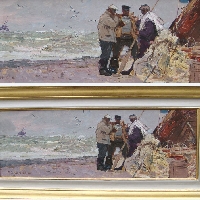(9) works in category
Biography
Piotr Kouzmitch STOLYARENKO was born in 1925 in Kerch, a delightful fishing village in the Crimea, o...
Petr Stolyarenko
Biography
Piotr Kouzmitch STOLYARENKO was born in 1925 in Kerch, a delightful fishing village in the Crimea, on the edge of the Azov Sea. His father was an amateur painter. Stolyarenko spent his early childhood with his French grandmother, who cultivated a vineyard stocked with Lyonnais vines at Kerrch. There he made his first pencil and charcoal reproductions of old Italian religious paintings, which adorned the walls of their home.
At the age of eight he was sent to live with his aunt to Feodossia. There he took his first painting lessons in the studio of Konstantin Bugayevsky, the painter. He was then noticed by Nikolai Barsarnov, pupil of the celebrated Konstantin Korovin, where he received more academic instruction. When his aunt died in 1940, he had to return to Kertch, only to be embroiled in the war which engulfed the region in 1941. The Crimea fell to the Germans and he was involved in the Resistance movement in there. After the Liberation, he returned to N.Barsarnov for further two years. On the advice of his teacher, he attempted to enter a highly respectful painting competition. He was judged good enough for entrance to the Fine Arts College in the city of Simferopol, Crimea. There he was accepted atraight into the final yaer. He graduated in 1950, diploma in hand, but highly unsatisfied with what he had been taught. He then temporarily gave up his artistic career and took to sea becoming a fisherman, as much as from love of the out of necessity, as much as from love of the sea. In that period he was still painting sporadically and was taking part in different exhibitions.
He had his first major exhibition in the early 1960's, among other works on show were "Seascape with Fishermen's Boats", "Foggy Morning", "The Soldier's Return", and the "Ivan and Maria" triptych. His paintings were at once very different from the standards of the time, typified by the patriotic heroes posing on huge canvases for propaganda purposes. Stolyarenko painted the daily life of the ordinary people around him, who like him had suffered the horrors of war. The paintings, tinged with romanticism, attracted great attention. The USSR Ministry of the Culture acquired some of them and Stolyarenko was soon awarded the title of Painter Emeritus of the USSR. That was the beginning of a long and fruitful career, during which his art was exhibited at more than one hundred major shows. He had solo exhibitions in Moscow, Spain, United States, Canada, Venezuela, Brazil, Japan and France. In 1984 he was awarded the title of People Artist of the USSR. The landscapes, still lifes and seascapes that formed the bulk of his work found their way to the walls of numerous prestigious museums in the USSR, and even to the homes of the Nomenklatura, including leonid Brezhnev and later Mikhail Gorbachev.
"What I want people to feel when they look at my paintings is that, for a brief instant, there are no people in them, that the garden is empty, that the mistress of the household has just left to get a jug of cold water, or gone in to glimpse at her child, sleeping inside, in the room next door."
Seascapes are Stolyarenko's favorite subject. Whether the Black Sea or the Sea of Azov, the sea in his paintings harks back to the artist's experiences in childhood and when he was working as a fisherman. The landscapes, the vineyards, the terraces like the Chekhov's house in the Crimea, which has become the artist's residence. In there he regularly enjoys the company of the painters of his generation, whom he loved to work with: Victor Vassine, Alexander Samokhvalov, Nathan Altman, Sergei Gerasimov. His seascapes, his depiction of fishing and sailing boats, are also inspired by his love and admiration of the Great Dutch Masters of the genre.
"The reflection of light on water, the way it plays and dances, is possibly the most difficult thing of all to paint. Every colour in the rainbow is there. The impressionists were supremely good at that, particularly Renoir. I have most appreciated to be able, at last, to see his canvasses in the Paris museums
"
Petr Stolyarenko lives and works in Yalta, the Crimea in a house near the sea. He also travels to paint in Europe: in Portugal, Italy, France, as well as to South America, Mexico and Cuba. He is devoted to training up his two grandsons, Alexei Stolyarenko and Grigorii Iefirnenko, promising scions of a family of artists.



